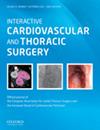Changes in aortic growth rate and factors influencing aneurysmal dilatation after uncomplicated acute type B aortic dissection
IF 1.6
4区 医学
Q3 CARDIAC & CARDIOVASCULAR SYSTEMS
引用次数: 1
Abstract
Abstract OBJECTIVES The aim of this study was to evaluate changes in aortic growth rate and factors influencing aneurysmal dilatation after uncomplicated acute type B aortic dissection (ABAD). METHODS Medically treated patients with uncomplicated ABAD between September 2004 and January 2020 were retrospectively reviewed. Diameters of 6 different sites in the descending aorta were measured and aortic growth rate was calculated according to the time interval. Factors associated with aneurysmal changes were also investigated. RESULTS This study enrolled a total of 105 patients who underwent >2 serial computed tomography with a mean follow-up duration of 35.4 (12.1–77.4) months. The mean overall growth rates of the proximal descending thoracic aorta (DTA), mid-DTA, distal DTA, proximal abdominal aorta, maximal DTA and maximal abdominal aorta were 0.6 (1.9), 2.9 (5.2), 2.1 (4.0), 1.2 (2.2), 3.3 (5.6) and 1.4 (2.5) mm/year, respectively. The growth rate was higher at the early stage. It decreased over time. Growth rates of proximal DTA, mid-DTA, distal DTA, proximal abdominal aorta, maximal DTA, and maximal abdominal aorta within 3 months after dissection were 1.3 (9.6), 12.6 (18.2), 7.6 (11.7), 5.9 (7.5), 16.7 (19.8) and 6.8 (8.9) mm/year, respectively. More than 2 years later, they were 0.2 (0.6), 1.6 (1.6), 1.2 (1.3), 0.9 (1.4), 1.7 (1.9) and 1.2 (1.7) mm/year, respectively. Factors associated with aneurysmal changes after uncomplicated ABAD included an elliptical true lumen (odds ratio = 3.16; 95% confidence interval: 1.19–8.41; P = 0.021) and a proximal entry >10 mm (odds ratio = 3.08; 95% confidence interval: 1.09–8.69; P = 0.034) on initial computed tomography imaging. CONCLUSIONS The aortic growth rate was higher immediately after uncomplicated ABAD but declined eventually. Patients with an elliptical true lumen and a large proximal entry might be good candidates for early endovascular intervention after uncomplicated ABAD.无并发症急性B型主动脉夹层后主动脉生长速率的变化及影响动脉瘤扩张的因素
摘要目的本研究旨在评价急性B型主动脉夹层(ABAD)术后主动脉生长速率的变化及影响动脉瘤扩张的因素。方法回顾性分析2004年9月至2020年1月间接受药物治疗的非并发症ABAD患者。测量降主动脉6个不同部位的直径,根据时间间隔计算主动脉生长速率。与动脉瘤改变相关的因素也进行了调查。结果本研究共纳入105例患者,他们接受了2次以上的连续计算机断层扫描,平均随访时间为35.4(12.1-77.4)个月。近段降主动脉(DTA)、中段降主动脉、远段降主动脉、近段降主动脉、最大段降主动脉和最大段降主动脉的平均总体生长率分别为0.6(1.9)、2.9(5.2)、2.1(4.0)、1.2(2.2)、3.3(5.6)和1.4 (2.5)mm/年。早期生长速率较高。它随着时间的推移而减少。解剖后3个月内,近端DTA、中端DTA、远端DTA、近端腹主动脉、最大DTA、最大腹主动脉的生长速率分别为1.3(9.6)、12.6(18.2)、7.6(11.7)、5.9(7.5)、16.7(19.8)、6.8 (8.9)mm/年。2年后分别为0.2(0.6)、1.6(1.6)、1.2(1.3)、0.9(1.4)、1.7(1.9)和1.2 (1.7)mm/年。单纯ABAD术后与动脉瘤改变相关的因素包括椭圆形真腔(优势比= 3.16;95%置信区间:1.19-8.41;P = 0.021),近端入路>10 mm(优势比= 3.08;95%置信区间:1.09-8.69;P = 0.034)。结论:无并发症的急性主动脉瓣破裂后主动脉生长速度立即升高,但最终呈下降趋势。具有椭圆形真管腔和大近端入口的患者可能是在无并发症的ABAD后早期血管内干预的好候选人。
本文章由计算机程序翻译,如有差异,请以英文原文为准。
求助全文
约1分钟内获得全文
求助全文
来源期刊

Interactive cardiovascular and thoracic surgery
CARDIAC & CARDIOVASCULAR SYSTEMS-
CiteScore
3.30
自引率
0.00%
发文量
292
审稿时长
2-4 weeks
期刊介绍:
Interactive CardioVascular and Thoracic Surgery (ICVTS) publishes scientific contributions in the field of cardiovascular and thoracic surgery, covering all aspects of surgery of the heart, vessels and the chest. The journal publishes a range of article types including: Best Evidence Topics; Brief Communications; Case Reports; Original Articles; State-of-the-Art; Work in Progress Report.
 求助内容:
求助内容: 应助结果提醒方式:
应助结果提醒方式:


